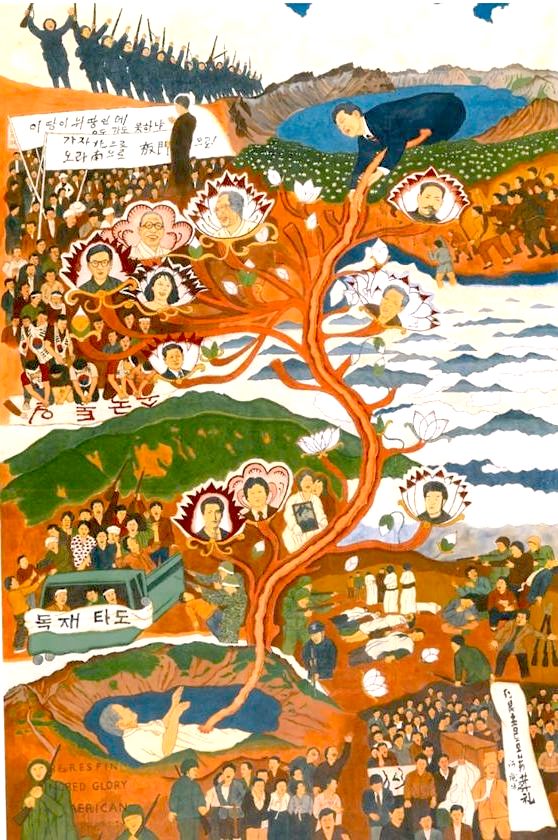As the world’s failure to stop massacre after massacre in Gaza shows the deep failure of the U.N.-centered international system, Vijay Prashad turns attention to the conflict looming over Northeast Asia.

Yuta Niwa, Japan, “Exterminating a Tiger-Wolf-Catfish,” 2021.
By Vijay Prashad
Tricontinental: Institute for Social Research
 It is impossible to look away from what the Israeli government is doing to Palestinians not only in Gaza, but also in the West Bank.
It is impossible to look away from what the Israeli government is doing to Palestinians not only in Gaza, but also in the West Bank.
Waves of Israeli aircraft pummel Gaza, destroying communications networks and thereby preventing families from reaching each other, journalists from reporting on the destruction and Palestinian authorities and United Nations agencies from providing humanitarian assistance.
This violence has spurred protests across the world, with the planet’s billions outraged by the asymmetrical destruction of the Palestinian people.
If the Israeli government claims that it is conducting a form of “politicide” — excising organised Palestinian forces from Gaza — the world sees Israeli aircrafts and tanks as conducting nothing but a genocide, displacing and massacring Palestine refugees in Gaza, 81 percent of whose residents were expelled from, or are the descendants of those who were expelled from, what was declared Israel in 1948.
All images coming out of Gaza show that Israel’s assault is unrelenting, sparing neither children nor women nor the elderly and sick. The failure of the world to stop massacre after massacre shows us the deep brokenness of our international system.
That broken international system, rooted in the U.N., brought us the conflict in Ukraine and is now egging on a dangerous confrontation in Northeast Asia, with flashpoints around the Korean peninsula and Taiwan.
While there are indications that the U.S. and China will restart the military talks that were suspended in August 2022 when former U.S. House Speaker Nancy Pelosi visited Taiwan in an act of reckless adventurism, this does not indicate lowered tensions in the waters around Northeast Asia.
For this reason, Tricontinental: Institute for Social Research, No Cold War and the International Strategy Centre have partnered to produce briefing Mo. 10, “The US and NATO Militarise Northeast Asia,” which makes up the rest of this week’s newsletter.

On Oct. 22, the United States, Japan and South Korea held their first-ever joint aerial drill. The military exercise took place after U.S. President Joe Biden, Japanese Prime Minister Fumio Kishida and South Korean President Yoon Suk Yeol gathered at Camp David in August “to inaugurate a new era of trilateral partnership.”
Although North Korea has frequently been invoked as a regional bogeyman to justify militarisation, the formation of a trilateral alliance between the U.S., Japan and South Korea is a key element of Washington’s efforts to contain China.
The militarisation of Northeast Asia threatens to divide the region into antagonistic blocs, undermining decades of mutually beneficial economic cooperation, and raises the likelihood of a conflict breaking out, in particular over Taiwan, entangling neighbouring countries through a web of alliances.
The Remilitarisation of Japan
In recent years, encouraged by the United States, Japan has undergone its most extensive militarisation since the end of the Second World War.
After Japan’s defeat, a new postwar constitution was drafted by U.S. occupation officials and came into effect in 1947. Under this “peace constitution,” Japan pledged to “forever renounce war […] and the threat or use of force as a means of settling international disputes.”
However, with the Chinese Revolution in 1949 and the breakout of the Korean War in 1950, the U.S. quickly reversed its course in Japan. According to U.S. State Department historians,
“the idea of a re-armed and militant Japan no longer alarmed U.S. officials; instead, the real threat appeared to be the creep of communism, particularly in Asia.”
The cause of amending and circumventing Japan’s “peace constitution” was taken up by the right-wing nationalist Liberal Democratic Party (LDP), which received millions of dollars in support from the U.S. Central Intelligence Agency during the Cold War and has ruled the country almost without interruption (except for 1993–1994 and 2009–2012) since 1955.
Over the past decade, the LDP has transformed Japan’s defence policy. In 2014, unable to amend the constitution, the LDP government led by Shinzo Abe “re-interpreted” it to allow for “proactive pacifism” and lifted a ban on Japanese troops engaging in combat overseas, enabling the country to participate in military interventions to aid allies such as the U.S.
In 2022, the Kishida administration labeled China “the greatest strategic challenge ever to securing the peace and stability of Japan” and announced plans to double military spending to 2 percent of gross domestic product (on par with NATO countries) by 2027, overturning Japan’s postwar cap that limited military spending to 1 percent of GDP.
The administration also ended a policy dating to 1956 that limited Japan’s missile capability to defend against incoming missiles and adopted a policy that allows for counter-strike abilities. This move has paved the way for Japan to purchase 400 U.S. Tomahawk missiles beginning in 2025, with the ability to strike Chinese and Russian naval bases located on the countries’ eastern coasts.

Shigeru Onishi, Japan, “Flickering Aspect,” 1950s.
Absolving Japanese Colonialism
Historically, Washington’s efforts to create multilateral alliances in the Asia-Pacific have failed due to the legacy of Japanese colonialism. During the Cold War, the U.S. resorted to a network of bilateral alliances with countries in the region known as the San Francisco System.
The initial step in creating this system was the San Francisco Peace Treaty (1951), which established peaceful relations between the Allied Powers and Japan.
To expedite the integration of Japan as an ally, the U.S. excluded the victims of Japanese colonialism (including China, the Kuomintang-led administration in Taiwan and both Koreas) from the San Francisco peace conference and excused Tokyo from taking responsibility for its colonial and war crimes (including massacres, sexual slavery, human experimentation and forced labour).
The new trilateral alliance among the U.S., Japan and South Korea has been able to overcome previous impediments because South Korea’s Yoon administration has waived away Japan’s responsibility for the crimes committed during its colonial rule over Korea (1910–1945). Specifically, the Yoon administration abandoned a 2018 South Korean Supreme Court ruling holding Japanese companies such as Mitsubishi responsible for the forced labour of Koreans. Rather than finally being held accountable, Japan has once again been let off the hook.

Lim Eung Sik, South Korea, “Looking for Work,” 1953.
Towards an Asian NATO?
In 2022, NATO named China a security challenge for the first time. That year’s summit was also the first attended by leaders from the Asia-Pacific region, including Japan, South Korea, Australia and New Zealand (these four countries participated again in 2023). Meanwhile, in May, it was reported that NATO was planning to open a “liaison office” in Japan, though the proposal appears to have been shelved — for now.
The U.S.-Japan-South Korea trilateral alliance is a major step towards achieving NATO-level capabilities in Asia, namely interoperability with respect to armed forces, infrastructure and information.
The agreement reached at the Camp David meeting in August commits each country to annual meetings and military exercises. These war exercises allow the three militaries to practice sharing data and coordinating their activities in real time.
In addition, the General Security of Military Information Agreement (GSOMIA) between Japan and South Korea — much sought after by the U.S. — expands military intelligence sharing between the two countries to not only be “limited to the DPRK’s missiles and nuclear programs but also includ[e] the threats from China and Russia.” This allows the U.S., Japan and South Korea to develop a common operational picture, the foundation of interoperability in the Northeast Asian military theatre.

Sangho Lee, South Korea, “Long for Korean Reunification,” 2014.
Waging Peace
Earlier this year, in reference to the Asia-Pacific, U.S. Ambassador to China Nicholas Burns declared that his country is “the leader in this region.” While China has proposed a concept of “indivisible security,” meaning the security of one country is dependent on the security of all, the U.S. is taking a hostile approach that seeks to form exclusive blocs.
Washington’s hegemonic attitude towards Asia is stoking tensions and pushing the region towards conflict and war – particularly over Taiwan, which Beijing has called a “red line” issue.
Defusing the situation in Northeast Asia will require moving away from a strategy that is centred on maintaining U.S. dominance. Those positioned to lead this movement are the people who are already struggling on the frontlines, from Gangjeong villagers who have opposed a naval base for U.S. warships since 2007, to Okinawans fighting to no longer be the U.S.’ unsinkable aircraft carrier, to the people of Taiwan who may ultimately have the most to lose from war in the region.
Northeast Asia has a long tradition of battles that fight to establish the good side of history against the ugly and dismal side. Kim Nam-ju (1946–1994) was a warrior of one of these battles, a poet and a militant in the minjung (“people’s”) movement against the dictatorships in South Korea, which imprisoned him, and many others, from 1980 to 1988. Here is his poem on the Gwangju Massacre in 1980:
It was a day in May.
It was a day in May 1980.
It was a night in May 1980, in Gwangju.
At midnight I saw
the police replaced by combat police.
At midnight I saw
the combat police replaced by the army.
At midnight I saw
American civilians leaving the city.
At midnight I saw
all the vehicles blocked, trying to enter the city.
Oh, what a dismal midnight it was!
Oh, what a deliberate midnight it was!
It was a day in May.
It was a day in May 1980.
It was a day in May 1980, in Gwangju.
At noon I saw
a troop of soldiers armed with bayonets.
At noon I saw
a troop of soldiers like an invasion by a foreign nation.
At noon I saw
a troop of soldiers like a plunderer of people.
At noon I saw
a troop of soldiers like an incarnation of the devil.
Oh, what a terrible noon it was!
Oh, what a malicious noon it was!
It was a day in May.
It was a day in May 1980.
It was a night in May 1980, in Gwangju.
At midnight
the city was a heart poked like a beehive.
At midnight
the street was a river of blood running like lava.
At 1 o’clock
the wind stirred the blood-stained hair of a young, murdered woman.
At midnight
the night gorged itself on a child’s eyes, popped out like bullets.
At midnight
the slaughterers kept moving along the mountain of corpses.
Oh, what a horrible midnight it was!
Oh, what a calculated midnight of slaughter it was!
It was a day in May.
It was a day in May 1980.
At noon
the sky was a cloth of crimson blood.
At noon
on the streets, every other house was crying.
Mudeung Mountain curled up her dress and hid her face.
At noon
the Youngsan River held her breath and died.
Oh, not even the Guernica massacre was as ghastly as this one!
Oh, not even the devil’s plot was as calculated as this one!
Change the word “Gwangju” for “Gaza” today and the poem remains vital. Our look at the reality unfolding in Northeast Asia should sharpen our understanding of what is going on in Southwest Asia – in Gaza, a frontline of a world struggle that bleeds with no end in sight.
Vijay Prashad is an Indian historian, editor and journalist. He is a writing fellow and chief correspondent at Globetrotter. He is an editor of LeftWord Books and the director of Tricontinental: Institute for Social Research. He is a senior non-resident fellow at Chongyang Institute for Financial Studies, Renmin U.N.iversity of China. He has written more than 20 books, including The Darker Nations and The Poorer Nations. His latest books are Struggle Makes Us Human: Learning from Movements for Socialism and, with Noam Chomsky, The With drawal: Iraq, Libya, Afghanistan and the Fragility of U.S. Power.
This article is from Tricontinental: Institute for Social Research.
Views expressed in this article may or may not reflect those of Consortium News.

I assume the people in Taiwan are seeing the same pictures of total destruction in Ukraine and Gaza that I am.
Why on earth would they want to get into a war with mainland China? Do they seriously want to hear Lindsey Graham explaining how “great a deal” Taiwan’s destruction is for the US? How many American jobs it’s creating?
The Japanese would do well to remember the atrocities the US committed against them when it dropped two nuclear bombs, and to understand that the US doesn’t have real friends, only countries that it can ‘persuade’ to join its cause.
It will use and abuse Japan and South Korea just like it used Ukraine – to fight its proxy wars, and do its dirty work.
Not only having Japan as an ally, but insisting on Japan’s rearming and calling China an enemy, the USA as usual wants to dominate without even considering cooperation with anyone it calls an enemy or even a rival.
North Korea is feared and threatened, but South Korea is in the grip of the USA, and throughout so many years the USA has chosen and supported governments that often have not been in the interest of South Korea. When a government in South Korea tries to overcome the enmity of the relationship with the North, the USA manages to overthrow it. None of this is leading to peace and cooperation, to win-win (the Chinese way!!)
I keep wondering what it is the US elites want from China. Communism is gone. Do they want a government as submissive as Japan’s? Or do they want Chinese people to be as poor and unhappy as the people of Iraq?
I don’t believe the talk about “human rights” and “democracy” from the US’ leaders. The US human rights record stinks like a truckload of dead fish. And somehow our “democratic” elections never changes anything important.
Who benefits from the constant militarism? Ordinary Americans get poorer and poorer, more likely to become homeless. Iraqis didn’t gain anything from US “liberation”. Being “defended” by the US promises to destroy Taiwan’s chip factories, first thing. Proably a lot of civilians will be “liberated” of their lives in the process.
Life is still cheap in Asia, isn’t it?
Comments are nice. Restating the problem is nicer yet. But, how does this solve the problem? Hope springs eternal but who’s going to solve the problem of arrogance, stupidity, sloth and ignorance?
It does not seem to be the voters! In the USA and Europe and of course the UK and five eyes, people are so propagandised by the media that they accept the leaders who have no interest in overcoming difficulties . Look at Biden, Scholtz, Macron,Meloni…….and even their opponents (Nikki Haley for POTUS!) and find not a shred of competence or intelligence (meaning BRAINS and decency, not information as in CIA!)
So much of the world’s ills today result from the American elite’s fear of communism, fear of making the changes so that all peoples could live in prosperity and peace. Such a world need not expel them, but their unbridled resistance to Truth makes them vulnerable to terrible destruction. The tragedy is that this destruction will be blanket and indiscriminate.
There are never enough wars for Democratic Party administrations.
Dems = Reps. They’ve both been eager for endless wars, coups d’etat, regime changes, proxy wars, since at least 1950.
The Democrats are not alone: Reagan, Bush Sr., Bush Jr,. Trump. Both parties are owned by the military industrial complex and Wall Street. Both parties have been in control nearly equally during the continuous wars of the 21st century.
V J,
Thé broke and immoral system is not — repeat not rooted in UN.
The immorality is rooted in each nation’s so-called leaders representing the fear and avarice of their puppet-masters.
No person-on-the-streeet — in any nation — wants genocidal bombing nor genocidal restriction of water, housing and health services!
There is money in war; there is artificial power in genocide.
Free the people in all nations to protest oppression — to be represented.
Thankyou & keep writing
You are right. The UN cannot function if countries do not follow the rules and international law. The USA is the main power to disobey, and Israel of course has its own “morality”, so even if 90% of the world would like certain actions, these two can and do prevent it.
I certainly think at this point that the Taiwanese would (and should) be ringing up Wang Yi, and saying, “Please come talk. We need to get out of US influence before they do for us what they’ve done for Ukraine.”